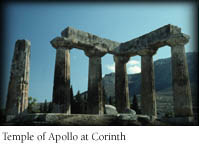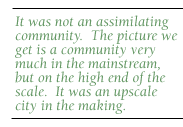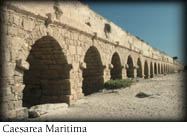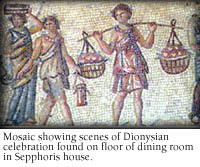Portraits of Greco-Roman Cities
What was it like to live in Corinth, Thessalonica, Sepphoris, and Caesarea Maritima? President of the Faculty, Union Theological SeminaryROMAN PROVINICIAL CITIES
Let's pretend you are a Roman official and you are arriving in Caesarea Maritima. What are you thinking?
Well, let's say into any sort of maritime Roman provincial capital.... You would have seen something that was typical of a lot of Roman cities, only on a very, very polished and grandiose scale. And I think the most important thing is that you would have seen the typical institutions of Roman culture.... You would have seen a Roman odeum, a Roman hippodrome, a place where you have the horse races. You would have seen shops with books in Latin and probably Greek as well on the wharves, a very lively commerce in the literary culture of Rome.... One would have stepped into a place typified by Roman society and culture, exemplified by Roman institutions of economy and political power....
You would have an enormous range and mix of people because certainly in the Mediterranean basin, on the maritime fringe of that basin, an enormous traffic in populations was going on, so that one would have found persons perhaps even from the sub-continent, certainly from the East, one would have found persons from Greece, from Egypt, from as far west as Gaul and perhaps even Britain.
What do you see when you leave the gates, the boundaries of the city, when you out into the countryside?
When you leave the Roman city, especially a provincial capital, you would see gradations of the city life, expressing itself primarily through what we call suburbs that were closely tied to the city. And then as one got more rural, the difference would become I think starker and starker and you would be really confronting or encountering two very disparate things: on the one hand the ongoing indigenous cultures and societies of the people who had lived there for centuries, if not millennia; on the other hand you would be seeing the intrusions of Roman economic power and in some instances political power. For example, there would have been in all the provinces large landed estates located primarily in rural areas, away from the cities. And these could be rather large, with populations upwards of a hundred. And it would have included, probably, a rather large slave population in which a number different ethnicities and nationalities would have been represented. Contrast that, then, to the indigenous populations who primarily were still either agrarian or tied to the support of the infrastructure of the cities, also in some instances tied to the landed estates.... But certainly one would encounter in the rural areas, aside from the landed estates, a degree of subsistence population that would have stood in stark contrast with the urban centers.
CORINTH
 Corinth would have been a fascinating city because it would have again exemplified the kind of maritime coastal city that we have in Caesarea Maritima. First you would have the harbor and all of the activity associated with that... One would have approached the city along a rather nice Roman highway. And as one would have approached, you would have first encountered a very nice sanctuary of Asclepius, which is where you went in antiquity to be healed, and according to the statutory regulations for Asclepius it would be located away from the city where there were fair breezes and out of the bustle and hustle of everyday urban life.... And then you would have moved on towards the city and entered along a rather monumental road called the Lechaion Way that would take you into the downtown city proper. And there would have been the magnificent temple of Apollo at Corinth that you would have encountered to the right as you came in the city. Presume by now that you would be on your feet because you weren't allowed to drive a wagon along the Lechaion Road, even though there were some interesting ruts on either side. One would have encountered, in the Roman period, a number of temples to civic deities, one would have encountered a library, one would have encountered a lot of shops.... And one would have also encountered, especially in Roman times, magnificent monumental baths. Baths were one of the principal ways in which locals could express their benefactions to the city, and they were of course integrally important for the economic and social life of the city as well.
Corinth would have been a fascinating city because it would have again exemplified the kind of maritime coastal city that we have in Caesarea Maritima. First you would have the harbor and all of the activity associated with that... One would have approached the city along a rather nice Roman highway. And as one would have approached, you would have first encountered a very nice sanctuary of Asclepius, which is where you went in antiquity to be healed, and according to the statutory regulations for Asclepius it would be located away from the city where there were fair breezes and out of the bustle and hustle of everyday urban life.... And then you would have moved on towards the city and entered along a rather monumental road called the Lechaion Way that would take you into the downtown city proper. And there would have been the magnificent temple of Apollo at Corinth that you would have encountered to the right as you came in the city. Presume by now that you would be on your feet because you weren't allowed to drive a wagon along the Lechaion Road, even though there were some interesting ruts on either side. One would have encountered, in the Roman period, a number of temples to civic deities, one would have encountered a library, one would have encountered a lot of shops.... And one would have also encountered, especially in Roman times, magnificent monumental baths. Baths were one of the principal ways in which locals could express their benefactions to the city, and they were of course integrally important for the economic and social life of the city as well.
Up above Corinth you would have encountered a very interesting phenomenon, the sanctuary of Demeter. At the sanctuary of Demeter we have beautiful examples of the dining rooms in which one would have dined. If you think about going out to eat in antiquity, you know, what do you do on Friday night? Well, the restaurants in effect were the dining facilities of the various temples, and so one would have gone to the temple of Demeter at Corinth and dined with the goddess or one of the other deities of the sanctuary as your host or hostess, and that would be your one principal way of recreation in antiquity.
THESSALONICA
As opposed to some of the other sites we're talking about, Thessalonica has a modern city on top of it. The modern Thessalonica. And if one would have approached, say from the sea in the Roman period, one again would have looked up the side of the coast and seen a city rising like an amphitheater from the water, again with a with a fortified acropolis at the top and then, in the Roman period, a stunning multi-terraced forum.
The forum in Thessalonica was quite distinctive because it was in a multi-terraced formation; one terrace would have had a very nice odeum and a ... covered portico around its side. Another terrace we know existed but we're not quite sure what was there. Certainly it appeared to be a place where statues of the emperors were displayed prominently. And then there would have been a third terrace as well. So it would have been quite dramatic, I think, looking up from the city as it rises above the coast and follows the contours of the land rather ingeniously....
One would also encounter a temple of Dionysius. Dionysius is one of the principal deities of Macedonia, of which Thessalonica was the provincial capital. And also a number of other cults, certainly one of Artemis. There's lots of evidence of Artemis in the city. And one of the beautiful things about Thessalonica is the geographical locale and the way the city is so nicely conformed to it. And one would have encountered residential quarters that would have been quite stunning. So Thessalonica again represented a sort of a typical Roman city in the period.
Professor of Religion and Archaeology Duke UniversityCAESAREA MARITIMA
 The demographics of the eastern Roman empire are really at the very core of understanding properly the setting of Jesus and first century Judaism in Palestine. Jerusalem was a multi-splendored city, as we know so well from sources. But Caesarea was the epitome of the great port city. The great city of mixed demographics, of mixed ethnic population. It had been for a long time before the Roman era because it was a major port. Herod's activities there made it into a major exit and transfer center where goods and supplies were coming in and other items being traded and going out. And it had a magnificent look to it. And it was full of sailors, it was full of soldiers. It was full of Romans because that's where the procurators were located. And it had a very diverse and upscale Jewish community. We know that its Jewish minority population in this period also functioned and ultimately developed into one of the significant Jewish centers in a later time. But the character of the city was oriental, splendored, splendid, beautiful, huge open port, ships coming and going.
The demographics of the eastern Roman empire are really at the very core of understanding properly the setting of Jesus and first century Judaism in Palestine. Jerusalem was a multi-splendored city, as we know so well from sources. But Caesarea was the epitome of the great port city. The great city of mixed demographics, of mixed ethnic population. It had been for a long time before the Roman era because it was a major port. Herod's activities there made it into a major exit and transfer center where goods and supplies were coming in and other items being traded and going out. And it had a magnificent look to it. And it was full of sailors, it was full of soldiers. It was full of Romans because that's where the procurators were located. And it had a very diverse and upscale Jewish community. We know that its Jewish minority population in this period also functioned and ultimately developed into one of the significant Jewish centers in a later time. But the character of the city was oriental, splendored, splendid, beautiful, huge open port, ships coming and going.
CAESAREA MARITIMA
 Caesarea Maritima is the city that Herod the Great founded to become his gateway to the Roman Empire. It was self-consciously planned to be a new city. A city that would give him access to the shipping lanes and to the commerce of the Roman Empire. And so, if one thinks of ... Caesarea and the great harbor that he built, you're looking at a place where he wanted people to see the world opening up ... the world opening up on his kingdom. So, it was to his grandeur that he was also developing this port.
Caesarea Maritima is the city that Herod the Great founded to become his gateway to the Roman Empire. It was self-consciously planned to be a new city. A city that would give him access to the shipping lanes and to the commerce of the Roman Empire. And so, if one thinks of ... Caesarea and the great harbor that he built, you're looking at a place where he wanted people to see the world opening up ... the world opening up on his kingdom. So, it was to his grandeur that he was also developing this port.
Herod designed this as a new harbor, precisely because there was no natural breakwater, was no natural port along that stretch of the coast. And so, he had to build an artificial harbor. He used Roman engineers, who were brought in, and they created the harbor, by floating barges out and sinking them with huge thirty ton blocks of either concrete or stone to form the underwater segment of the harbor. On these foundations, then, he would create the inner harbor, the shipping lanes, and the warehouse system that would be Caesarea Maritima. In the middle of the city, was a Roman city complete with the capital, temples to the deified Roma, that is the personification of Rome, itself, as well as to the Emperor Augustus, who was Herod's patron.
I thought Herod was a Jewish king. Shouldn't there be synagogues, shouldn't there be a mausoleum?
Well, there were, in fact, synagogues in Caesarea. We hear of them later on. And at times, there were some tensions as a result of this. But this was a Roman city, it was planned and laid out like a Roman city. A very square, Roman street plan, with a theater, with an amphitheater, with all the accouterments of Roman civic life, and a great deal of Hellenistic influence as well.
SEPPHORIS
Eric Meyers
Sepphoris was a city that existed already in Hellenistic times, first, second century BCE. But it was really developed by Herod's son Antipas, when he went there in 4 or 3 before the Common Era, after his father's death. The extent of his activities, however, as described by none other than Josephus, the historian of this era, is very complicated. It's alleged by many scholars that his building scheme resembled that of his dad's in Jerusalem. But after a dozen years excavating at the site, it's very difficult to come up with the fixings of a real eastern Roman city in the time of Jesus or at the beginning of the first century in the time of Antipas....
The theater that everyone assumes was built in the time of Jesus or in the time of Antipas, in my opinion and I think now in the opinion of all of the excavators of the site, was not begun until the second half of the century, if not the beginning of the second century, C.E.... We have wonderful upper class villas in which Jews and priests lived, some of them with very close connections to Jerusalem. And we have a series of first century ritual baths, used for complete immersion, to deal with the Levitical command as found in the Hebrew Bible, to honor the commandment of ritual purity, bodily purity....
So Antipas beautified the city, but it was not yet a great city of the Roman East. I'm absolutely certain of this. This happened later when the theater is erected and when Roman Legionnaires and soldiers come and establish their presence and make themselves known at the beginning of the second century. There's one other clue that tells us very much about the character of first century Sepphoris. And that surprisingly, comes from the bones that we find in these houses and in these villas. We have virtually no pig bones attested in the early Roman period at Sepphoris. Occasionally, we find an odd bone here or there of swine, but virtually none. When we go up to other centuries, even the second century, we find a significant increase, up to 8 or 10 percent of the bones are pigs, and no doubt these are being presented, by virtue of the presence of the Roman Army. And by the fourth century when there are Christians there we've got 18 percent, 20 percent pig bones....
I think the beginnings of Jewish culture in Sepphoris, as we can reconstruct them now from archaeology in the first century, might be characterized as upscale, living very much as some of the Jews from Jerusalem might have lived at the same time in the Jewish quarter. We have frescoed rooms. We have houses, each with its own private ritual bath. That's an extravagance, considering where the water had to be brought from and the kind of technical [manueverings] it took to get pure water mixed with standing water. But it was very much in the mainstream. I don't think they were doing anything that they shouldn't have done. It was not an assimilating community. The picture we get is a community very much in the mainstream, but on the high end of the scale. It was an upscale city in the making. Not yet a real city of the east, but a city surely that was born in the time of Antipas.
MONA LISA OF THE GALILEE
 One of the more exciting discoveries that we made at Sepphoris was a magnificent Roman villa with a gorgeous, gorgeous mosaic on its floor in a banquet hall. And this villa, which we call the Villa of Dionysus because so many of the scenes are concerned with the legend and mythology of the god Dionysus, has at two of its ends in this banquet hall, one very attractive woman and one not so attractive woman. The lady who is not so attractive was not depicted as well as the other, but she was also injured badly during the great earthquake which destroyed Sepphoris in 363. But the lady on the other side was dubbed "Mona Lisa" by the press when we found her because she's really an extraordinary depiction in stone of a beautiful woman of Roman antiquity. She might be one of the four seasons. But one has the feeling that behind that face was a real woman and a real figure. Because the artistry that depicts it in stone is so delicate and so exquisite and so painterly. And so she has become kind of synonymous with the site even though she's from the 3rd century, the high point of Hellenization at the site. She has now become synonymous with the Romanization of the site and Hellenization....
One of the more exciting discoveries that we made at Sepphoris was a magnificent Roman villa with a gorgeous, gorgeous mosaic on its floor in a banquet hall. And this villa, which we call the Villa of Dionysus because so many of the scenes are concerned with the legend and mythology of the god Dionysus, has at two of its ends in this banquet hall, one very attractive woman and one not so attractive woman. The lady who is not so attractive was not depicted as well as the other, but she was also injured badly during the great earthquake which destroyed Sepphoris in 363. But the lady on the other side was dubbed "Mona Lisa" by the press when we found her because she's really an extraordinary depiction in stone of a beautiful woman of Roman antiquity. She might be one of the four seasons. But one has the feeling that behind that face was a real woman and a real figure. Because the artistry that depicts it in stone is so delicate and so exquisite and so painterly. And so she has become kind of synonymous with the site even though she's from the 3rd century, the high point of Hellenization at the site. She has now become synonymous with the Romanization of the site and Hellenization....
 The discovery of these scenes of the mythology of Dionysus on the floor of a public house in a banquet hall in a Jewish town certainly blew most everyone's mind. And made us think for the first time that there was a much more liberal attitude towards the second commandment banning pictorial images in Judaism and that Jews in general were much more flexible with respect to image making and artistic presentation and activity, in the very period where the Mishna, the first major Jewish body of law to be codified in Palestine at Sepphoris in the third century, was being produced side by side with this great piece of work.
The discovery of these scenes of the mythology of Dionysus on the floor of a public house in a banquet hall in a Jewish town certainly blew most everyone's mind. And made us think for the first time that there was a much more liberal attitude towards the second commandment banning pictorial images in Judaism and that Jews in general were much more flexible with respect to image making and artistic presentation and activity, in the very period where the Mishna, the first major Jewish body of law to be codified in Palestine at Sepphoris in the third century, was being produced side by side with this great piece of work.
